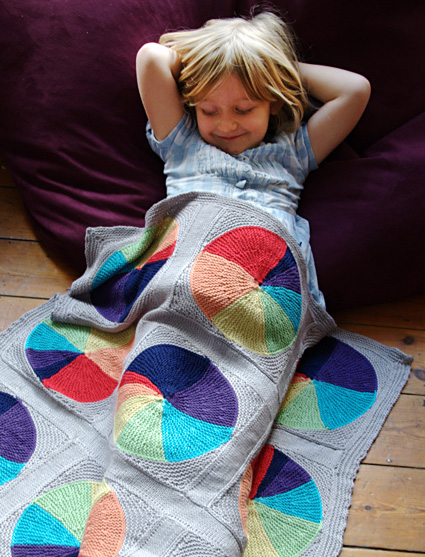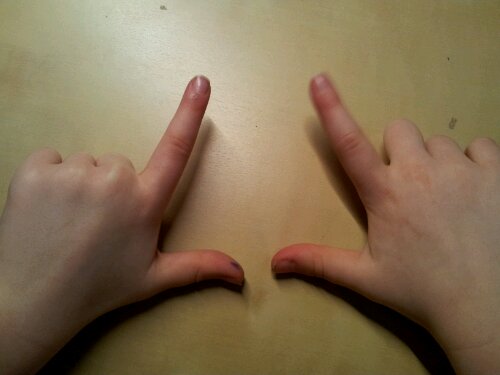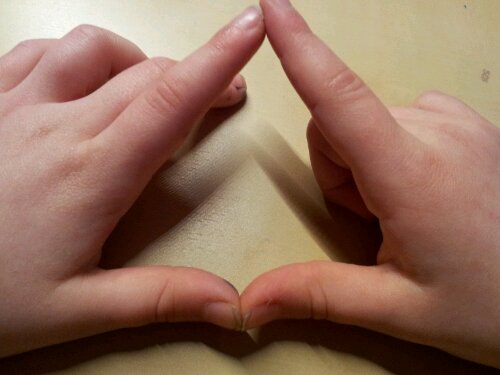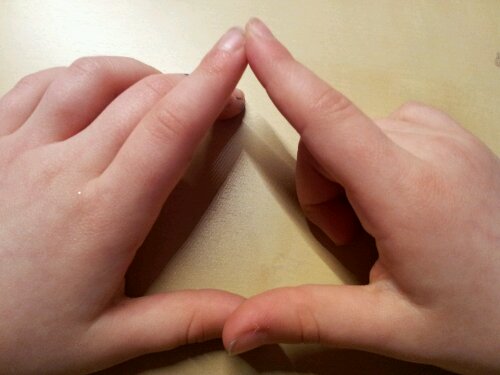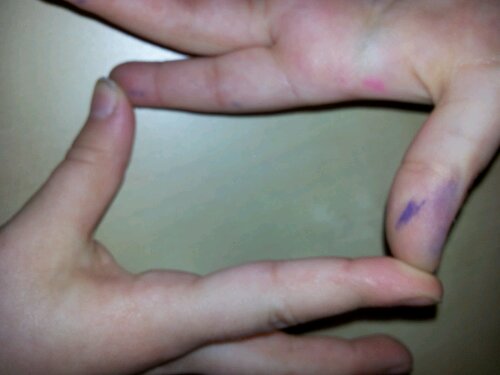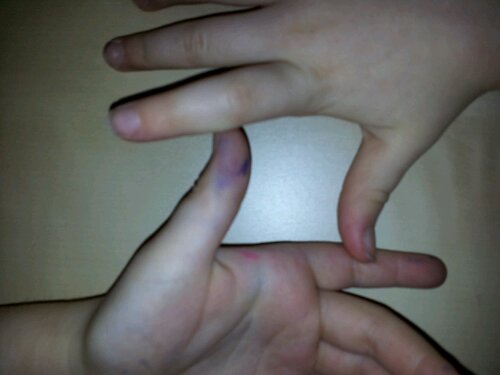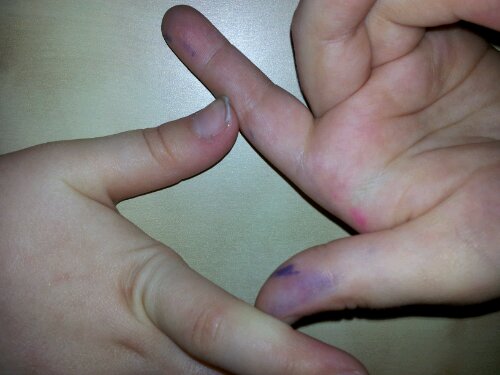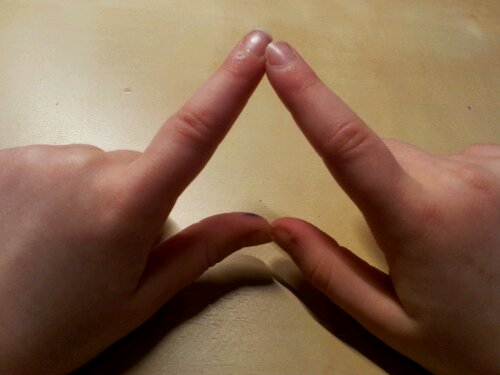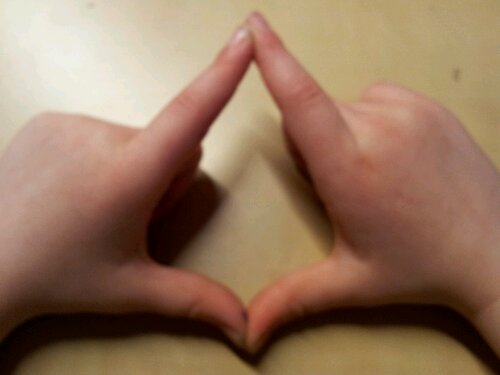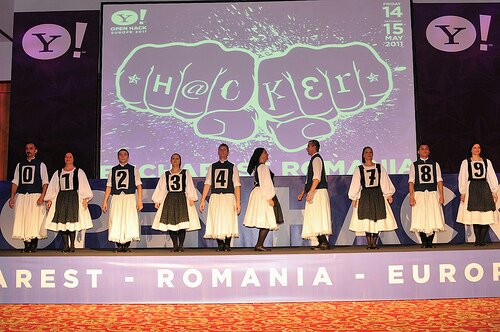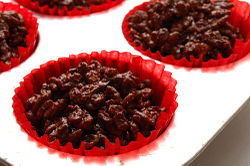I love this free pattern on Knitty.
Monthly Archives: March 2013
39. So simple a child could do it
Forget making hearts with your hands – that’s so 2012! Triangles and quadrilaterals are the way to go.
This is quicker than getting whiteboards out, can be used as a memory aid and keeps mischievious fingers busy.
Getting started
The basic L shapes (my assistant had been busy with felt tip pens before being photographed).
Isosceles Triangle
Index figures and thumbs together.
Equilateral Triangle
Index figures together, thumbs overlapping.
Rectangle
Index fingers and thumbs joined at 90 degrees.
Parallelogram
As for the rectangle, but opposite angles equal (as opposed to 90 degrees).
Square
Thumbs part way down index fingers at 90 degrees.
Rhombus
As for the square, but opposite angles equal (rather than 90 degrees).
Arrowhead Kite
Index fingers together, thumbs together, all pointing upwards.
Kite
Index fingers pointing up, thumbs pointing down.
38. Quick Constructions
A quick idea today.
Most Maths Departments use squared paper exercise books. Great for lots of mathematical concepts, but not constructions.
How many times have you seen a perpendicular bisector drawn using the right angle from the squared paper with some freehand scrawled ‘construction’ lines?
The solution to this topic is so simple – use plain paper. But then they forget to stick in their book or lose it!
The best activity I have used is to use folded A4 plain paper for the whole constructions topic. Pupils must annotate their work with instructions and revision hints. When you finish, you give them a coloured paper or card cover to attach. You could include a printed summary of skills on it.
The final homework is to illustrate the cover of the booklet with their favourite technique or related design.
This task is so easy to do, involves little preparation, creates a useful revision resource and promotes independent learning.
(The diagram is from BBC bitesize website which has some nice revision activities on this)
37. Bubble Sort Folk Dance
This video by AlgoRythmics is a brilliant way to introduce Hungarian Folk Dance, I mean the Bubble Sort algorithm to a Decision Maths class.
It was created at Sapientia University.
36. Pythagoras Squirrel
I stumbled across this website ages ago and I still go back for this activity.
Who knew a crazy squirrel could take the fear out of basic pythagoras?
The picture is Secret Squirrel and Morroco Mole – if you remember them, you’ve probably been teaching quite a while …
35. Ratio that is good enough to eat
I originally did this activity for a class that I taught twice in a day, but it would work equally well on sequential days.
Equipment
Recipe cards labelled A, B, C, D
Microwave or friendly food tech teacher who will lend you their room
Rice Crispies (or Cornflakes)
Chocolate
Bowls & spoons
Oven glove
Cake cases
Aim
If you haven’t guessed from the equipment list, you are making chocolate rice crispie cakes to investigate ratio.
Before you start
You need to have at least 4 different recipe cards. Two of them should have the same ratio of chocolate to cereal, but in different quantities. I had one as double the other. The other two should have common errors eg adding rather than multiplying to increase.
Practical
The messy part.
Make the rice crispie cakes and leave them to set. You should make sure each set of cakes is labelled with the recipe letter.
Discussion
This is the fun part. Taste testing in the second lesson – they will be keen to get started.
Each pupil tries each recipe and comments on how they taste. Depending on your recipes, one should be too dry, one should be too chocolatey* and two should be identical. You can then look at the recipes to explain this by comparing quantities and introducing ratio.
*Some will say you cannot have too much chocolate, but if you use Mars bars the high sugar content means they go rock hard if there is not enough cereal. So hard in fact that two boys decided to eat a whole cake each because no one else wanted them and they were quiet for more than ten minutes!
You’re being watched…
I first did this activity 10 years ago when I knew I was being watched by my Head of Department in the tasting/discussion section. The class were a bouncy low ability Y9 group.
They loved it, my HoD loved it and it’s never let me down as a lesson concept since.
34. The Dancing Cipher
A different way to look at data and probability is to introduce letter frequency analysis.
I set pupils the task of finding out the letter frequency data for the english language. Not much of a challenge for a bright student with the internet.
However …
I then gave them four A4 sheets of symbols to decode. Literally four pages of code, with no hints except they had to determine two literary works and authors from it. They had two weeks to solve it.
In hindsight, they described it as the best homework ever. I had parents contact me to see if they had solved it correctly – not to help their child, they were in competition to see who would get it first!
How to do it
Pick a text which is freely available on the internet – it saves typing out pages of text. I chose ‘Through the Looking Glass’ by Lewis Carroll – lots of interesting words!
I found a great website which gives you the Dancing man cipher amongst others. You paste in your text and select your substitution cipher. It then encodes your text for you. I chose the Dancing Man as it was the second literary work: The Adventure of the Dancing men (A Sherlock Holmes story)
I pasted this into Word and this formed the homework.
The interesting thing about this substitution cipher is that it has 52 symbols and no spaces. It is tricky to cheat as you would have to know the name of the cipher and the full cipher was not published in the book. There is more than one variation of the code as different people have tried to fill in the missing symbols.
Classics
This task ticks all the boxes for data processing, coding, independent study and literacy. In fact several pupils came back and said they had read Conan-Doyle’s classic work as a result of a maths task.

